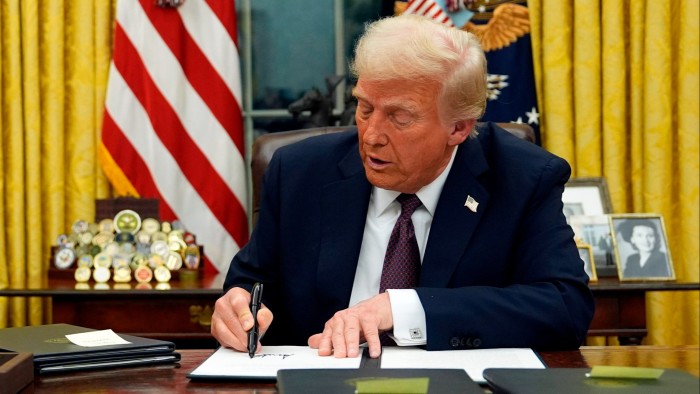The sharp sell-off in US bonds may not yet be over, say fund managers and analysts, as they try to work out the longer-term impact of President Donald Trump and his policies on Treasury yields and prices.
Investors have already seen the yield on the 10-year Treasury rise from as little as 3.6 per cent in mid-September to about 4.8 per cent this month — its highest level since November 2023 — before falling back, slightly, to about 4.64 per cent. Bond yields move inversely to prices.
These moves have been driven, in part, by the so-called “Trump trade”, as investors started to price in an election victory for the Republican candidate and resulting policies that could add further fuel to an inflation rate already above target.
With yields of 5 per cent being talked about as a possibility by some commentators — and little clarity on how Trump will pursue his plans for trade tariffs, tax cuts and deportations of illegal immigrants — many see little reason to call an end to the rises just yet.
“We don’t want to get in the way of the rise in US Treasury yields right now as it could be based upon markets testing a shift to a new regime, as Trump [tariff] threats are taken more seriously,” explained TS Lombard chief economist Freya Beamish, in a recent note.
Strong jobs market data and above-target inflation have added to jitters among investors. US consumer price inflation was 2.4 per cent in September but ticked up to 2.9 per cent in December, although core inflation for that month unexpectedly fell. On the Federal Reserve’s preferred Personal Consumption Expenditure measure, inflation was 2.4 per cent in November — still above the central bank’s 2 per cent target.
These metrics means that, for many fund managers, Treasuries — traditionally seen as a haven asset — are a riskier, more volatile bet than in the past.
“Investors are demanding more compensation to hold an asset class that has more uncertainty,” says Matthew Morgan, head of fixed income at Jupiter Asset Management. “Inflation is not going away as quickly — that’s the primary problem. The starter of this move was as much [the inflation] data as Trump.”
Many investors remain concerned about the federal budget deficit, which grew under former president Joe Biden to $1.8tn in the year to September — or more than 6 per cent of US GDP. Last year, the Congressional Budget Office forecast it would hit $2.6tn by 2034.
Despite Trump’s plan to cut the deficit to 3 per cent, and his appointment of Elon Musk to head a project to slash the size of the state, many commentators expect the deficit to grow under the new president. This has raised concerns about the amount of bond issuance required.
“The US [deficit] is wide,” says Mitch Reznick, group head of fixed income in London at Federated Hermes. “It can generally operate wider than other jurisdictions, but there are limits to that.
“We’re still a little bit wary of the long end in bonds, [until] we see catalysts of growth and deficits under control,” he adds.
Greg Venizelos, fixed-income strategist at St James’s Place, cites “the uncertainty we’ve seen surrounding Trump 2.0” as a factor behind the surge in yields, and says the firm’s house view is to be neutral on government bonds.
However, some investors have been using the sell-off as an opportunity to buy. Jupiter’s Morgan says that the firm’s fund managers have, on balance, been increasing their positions in longer-term bonds more sensitive to moves in interest rates.
“Government bonds look attractively priced right now,” he suggests. “I think you’re going to make money on a 12- to 24-month view, but you’re going to take some volatility.”
Fund managers have also been trying to take advantage of the upheaval in the Treasury market by betting on the steepening of the yield curve, as yields on longer maturity debt have risen relative to those on shorter-term bonds. Traders can profit by betting on shorter-term debt prices rising while betting against longer-term bonds.
The so-called term premium — the extra return for investors for taking on interest rate risk over longer periods — has risen to its highest level since 2014, according to data from the Federal Reserve.
The recent move in 10-year bonds globally, which steepened yield curves around the world, has been “spectacular”, wrote Natixis, in a note to clients.
Federated Hermes’ Reznick and fund managers under Jupiter’s Morgan are among those to have run ‘steepener’ trades. Michael Krautzberger at Allianz Global Investors has also had such trades on, and has taken some profits.
But, while Treasury moves have been dramatic, some commentators believe certain threats to the market posed by Trump could prove to be overblown. For example, plans to introduce widespread tariffs may be scaled back, as indicated by some of the president’s comments since his inauguration.
“Ultimately, we see scope for a [trade] deal to be done avoiding materialisation of these threat[s] . . . providing opportunities for a reprieve,” said TS Lombard’s Beamish last week.
Read the full article here

